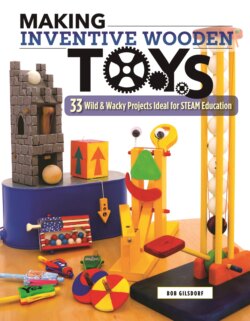Читать книгу Making Inventive Wooden Toys - Bob Gilsdorf - Страница 8
ОглавлениеDESKTOP ROCKETS
This project was inspired by my mild disappointment with retractable ballpoint pens. Yes, they are ingenious little contraptions with a clever latching mechanism and a spring-loaded button that prevents large ink spots from growing in your pocket. Where’s the disappointment? Well, have you ever pushed that button down on a desk and then released the pen? Of course you have, everyone has. The pen hops a disappointing inch or so. The kid in me wants the pen to soar at least several feet in the air to the altitude where my imagination can turn it into something spectacular and sound effects can be added. So that’s what I set out to accomplish—a desktop rocket that would gain some serious altitude and ignite a kid’s imagination.
MATERIALS
• ¾" x 1 ½" x 2 ½"
(2cm x 4cm x 6cm) pine board (aka a chunk of 1"x2")
• ⅜" (1cm) dowel
5 ½" (14cm) long
• ¼" (6mm) dowel
1 ½" (4cm) long
• #64 3 ½" x ¼" (9cm x 6mm) rubber band
TOOLS
• Scissors
• Ruler
• Pencil
• Coping saw or scroll saw
• Awl
• Drill with bits: ⅛" (3mm), ¼" (6mm), ½" (13mm)
• 3" (8cm) of thin wire
SMART ROCKET:
Let your rocket help you make decisions. Write "Yes" on one side and "No" on the other. Ask your rocket a question and then launch it to get the answer.
REVERSE ENGINEERING
First, let’s take apart a pen to see what makes it jump. Aha! What we find is a very tiny spring on one side of the ink tube. No wonder it doesn’t hop very high.
MORE SPRING
If we want the rocket to go higher we’ll need to design something with a larger spring.
SIMPLER ROCKET FUEL
The perfect spring can be hard to find. So rather than compressing a spring to store energy, we can simplify our rocket by instead stretching a rubber band. This makes it very easy to experiment with a wide variety of rubber bands.
Use your measuring and marking tools to mark the dimensions and locations shown. The grain should run lengthwise down the rocket body. Use an awl to mark the locations of the holes. These small indentations will keep your bit from wandering. Cut the rocket body to the 1 ½" by 2 ½" size. Drilling holes in square boards is much easier than drilling holes in weirdly shaped boards. Drill the holes in the rocket body and fuel rod. Use a clamp and a drill press to drill the hole for the fuel rod.
Note: Patterns are not drawn to scale.
Insert the pins into the holes in the rocket body. Glue them in place with about ¼″ (6mm) protruding from the sides, making sure that neither pin is visible in the hole for the fuel rod.
Pull a rubber band through the hole in the fuel rod. I use a thin wire. Make sure there are equal lengths of rubber band on either side of the fuel rod.
Place the fuel rod into the hole in the rocket body. Make sure the end with the rubber band is at the narrow top of the body. Loop each side of the rubber band around a pin on either side.
TEST PILOT
WARNING: Safety always comes first. You don’t know how high your rocket will soar, so before launching the rocket be sure there is nothing above you, such as a fluorescent light, ceiling fan, satellite, or (more importantly) any part of you!
ROCKETS AWAY
Launch the rocket by pinching both sides of the body between your thumb and forefinger. Place the end of the fuel rod on the table and press down on the rocket body until the base of the body is flat on the table surface. Release your fingers and watch your rocket soar. For a higher launch try licking your fingers. After testing the rocket out, sand, shape, and decorate it in a variety of ways.
